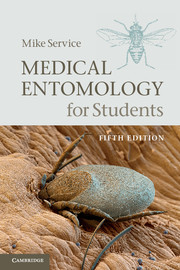Book contents
- Frontmatter
- Contents
- Preface to the first edition
- Preface to the second edition
- Preface to the third edition
- Preface to the fourth edition
- Preface to the fifth edition
- Acknowledgements
- 1 Introduction to mosquitoes (Culicidae)
- 2 Anopheline mosquitoes (Anophelinae)
- 3 Culicine mosquitoes (Culicinae)
- 4 Black flies (Simuliidae)
- 5 Phlebotomine sand flies (Phlebotominae)
- 6 Biting midges (Ceratopogonidae)
- 7 Horse flies (Tabanidae)
- 8 Tsetse flies (Glossinidae)
- 9 House flies and stable flies (Muscidae) and latrine flies (Fanniidae)
- 10 Flies and myiasis
- 11 Fleas (Siphonaptera)
- 12 Sucking lice (Anoplura)
- 13 Bedbugs (Cimicidae)
- 14 Triatomine bugs (Triatominae)
- 15 Cockroaches (Blattaria)
- 16 Soft ticks (Argasidae)
- 17 Hard ticks (Ixodidae)
- 18 Scabies mites (Sarcoptidae)
- 19 Scrub typhus mites (Trombiculidae)
- 20 Miscellaneous mites
- Appendix Names of some chemicals and microbials used in vector control (with common trade names in parentheses)
- Glossary of common terms relevant to medical entomology
- Select bibliography
- Index
- Plate section
- References
7 - Horse flies (Tabanidae)
Published online by Cambridge University Press: 05 June 2012
- Frontmatter
- Contents
- Preface to the first edition
- Preface to the second edition
- Preface to the third edition
- Preface to the fourth edition
- Preface to the fifth edition
- Acknowledgements
- 1 Introduction to mosquitoes (Culicidae)
- 2 Anopheline mosquitoes (Anophelinae)
- 3 Culicine mosquitoes (Culicinae)
- 4 Black flies (Simuliidae)
- 5 Phlebotomine sand flies (Phlebotominae)
- 6 Biting midges (Ceratopogonidae)
- 7 Horse flies (Tabanidae)
- 8 Tsetse flies (Glossinidae)
- 9 House flies and stable flies (Muscidae) and latrine flies (Fanniidae)
- 10 Flies and myiasis
- 11 Fleas (Siphonaptera)
- 12 Sucking lice (Anoplura)
- 13 Bedbugs (Cimicidae)
- 14 Triatomine bugs (Triatominae)
- 15 Cockroaches (Blattaria)
- 16 Soft ticks (Argasidae)
- 17 Hard ticks (Ixodidae)
- 18 Scabies mites (Sarcoptidae)
- 19 Scrub typhus mites (Trombiculidae)
- 20 Miscellaneous mites
- Appendix Names of some chemicals and microbials used in vector control (with common trade names in parentheses)
- Glossary of common terms relevant to medical entomology
- Select bibliography
- Index
- Plate section
- References
Summary
Tabanids are large biting flies generally called horse flies, although other vernacular names include greenheads (some species of Tabanus), clegs and stouts (Haematopota) and deer flies (Chrysops). All belong to the family Tabanidae, which comprises about 4300 species and subspecies in 133 genera. Medically the most important are species of Tabanus, Chrysops and Haematopota. Tabanids have been incriminated in the spread of anthrax and tularaemia and might be involved in the transmission of Lyme disease (usually transmitted by hard ticks), but this remains unclear. But their main medical importance is that species of Chrysops, mainly C. silaceus and C. dimidiatus, are vectors in West and Central Africa of the filarial worm Loa loa.
The Tabanidae have a worldwide distribution. Species of Tabanus and Chrysops are found in temperate and tropical areas, but Haematopota is absent from South America and Australasia and is uncommon in North America.
External morphology
A generalized description is presented of the Tabanidae, with special reference to the genera Chrysops, Tabanus and Haematopota.
Tabanids are medium to very large flies (6–30mm long). Many, especially Tabanus species, are robust and heavily built, and this genus contains the largest biting flies, some with a wingspan of 65 mm. The colouration of tabanids varies from very dark brown or black to lighter reddish brown, yellow or greenish; frequently the abdomen and thorax have stripes or patches of contrasting colours (Fig. 7.1). The head is large and, viewed from above, is more or less semicircular (Fig. 7.2); it is often described as semilunar. The head has a conspicuous pair of compound eyes which in life may be marked with contrasting iridescent colours, such as greens and reds or even purplish hues, arranged in bands, zigzags or spots. Adults are sexed by examining their eyes. In the female there is a distinct space on top of the head separating the eyes: this is known as a dichoptic condition (Fig. 7.2a). In females of some species this space between the eyes may be narrow, whereas in others, especially Chrysops, it is quite large. In males the eyes are so large that they occupy almost all of the head and either touch each other on top of the head or are very narrowly separated, this being known as a holoptic condition.
- Type
- Chapter
- Information
- Medical Entomology for Students , pp. 116 - 125Publisher: Cambridge University PressPrint publication year: 2012
References
- 1
- Cited by



